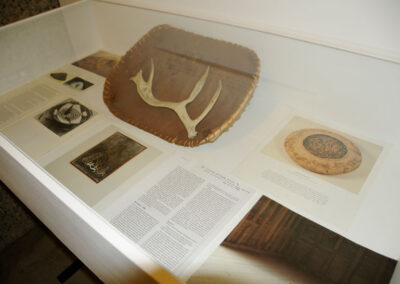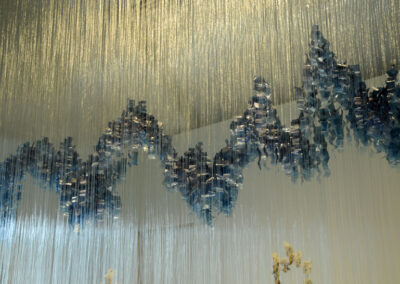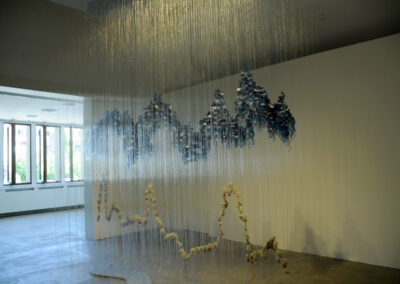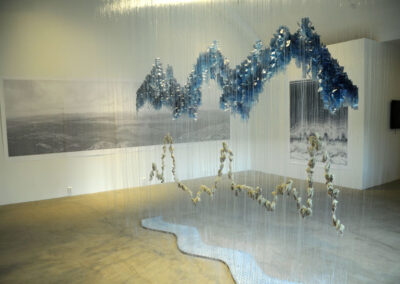Installation for Oppland Artcentre
Lillehammer, NorwayThe opening show of this new artist run gallery in Lillehammer.
Inside: Chris Drury and Svein Flygari Johansen
Outside around the town: Jannecke Lønne Christiansen, Anna Widén, Marit Hosar, Marit Arnekleive, Egil Martin Kurdøl, Ådne Løvstad.
The Exhibition runs from 15th June – 14th August 2014
I met Patrick at the Pori Art Museum in Finland and he asked me to take the main space in this new gallery, to make an installation, some works on the wall and to do an archive room to explain to the Norwegians what my work has been pursuing over the years. Kay Syrad and I put this together and she installed it. Here is what I said about the ideas around the show:
Coming Full Circle – Chris Drury
Putting together an archive of the last 30 years of work has been interesting and I realise that the four works in the main exhibition room cover most of the themes that I have been exploring over these years. These are best summed up by something I wrote in 1995 and which Kay Syrad quoted at the beginning of her introduction to my book Silent Spaces:
The edge is the division.
What is known is always from the past.
Through knowledge the new is a reworking of the old.
The sum total of knowledge is culture.
Culture is the veil through which we describe nature.
The process of nature continues despite our analysis.
Our analysis is part of the process of nature.
The process of nature must include the actions of man
whether or not they are destructive.
Man’s description of ‘nature’ as something separate –
out of town – where the edge is the division
between ‘nature’ and ‘culture’, is an illusion.
‘Nature’ and ‘culture’ are the same thing.
There is no division.
The video piece Breath/Anail is a collaboration with Andy Mackinnon and it was made for that same original show – Land, Water and Language. The word anail is Gaelic for breath and has a resonance with the English word inhale. The continually breaking wave is like a breathing in and a breathing out. The work is echoed in the two other works in the exhibition, which have connections to science. The obvious connection to the breaking wave is sound and light waves. In Quantum Mechanics light is composed of either particles or waves depending on how the viewer sees it at the time – this is wave-particle duality.
The background to Double Echo was my residency in Antarctica in 2007 with the British Antarctic Survey. I was deep in the interior with a group of scientists who were looking at the structure and flow of the ice beneath us – some 4 kilometres of it, built up over 900,000 years. By using radar fixed to the undersides of small aircraft they would fly on a predetermined course for four hours. The radar pulse would be sent down through the ice to the Antarctic landmass and back up into a computer, giving an amazing cross section of ice and land beneath the flight of the plane. One of the scientists, in showing me these images and knowing of my interest in the patterns of the heart, said that these echograms were looking at the ‘heartbeat of the Earth’. For Double Echo I persuaded the pilot who flew these echogram flights to have his heart read by echocardiogram at a London hospital where I knew the doctors on the cardiac ward. An echocardiogram shares a similar technology to echograms except that it uses sound rather than radar. The resulting image here is a superimposition of both the human and Earth heartbeat: waves of sound, waves of ice, waves of water, waves of time, waves of breath and the waves of a beating heart.
The installation Wave Particle takes Double Echo and turns it into a 3-dimensional experience. The floating, semi-transparent rectangular prism is made up of approximately 4000 strands of hanging nylon thread, stretching from ceiling to floor and taking up an area 3 m. x 1.5 m. x 4 m. high. It creates a veil for the whole room, partially obscuring and changing how both people and art works appear while at the same time catching the light and reflecting it back. It is an attempt to combine waves and heartbeats in three dimensions. The wave is both vertical (a curtain of 864 blue nylon threads) and horizontal (strung fragments on the threads), re-drawing in three dimensions both the Antarctic mountain range and the human heartbeat, moving horizontally across the vertical curtain wave, delineated by the blue thread. The mountain range is composed of folded fragments of printed ice layers on acetate, from an echogram strung onto the threads, and the heartbeat is made up of fragments of reindeer moss tied to the same threads on a lower level. The blue threads are stretched taut between hooks on the ceiling and floor and surrounded by a veil of loosely hanging clear thread to complete the prism. The work took two weeks to construct with many around 6 people a day helping to tread and hang threads. In a way the work was a kind of endurance performance whose outcome was never certain. Thanks goes to Ragnild, Ruth, Kristin, Frederick, Britt, Halvard, Ramesh, Alexander, Jorid, Anne Lise, Frøydis and Randi. A special thanks goes to Eli Kongsshund, the director of the gallery who masterminded the whole process.





